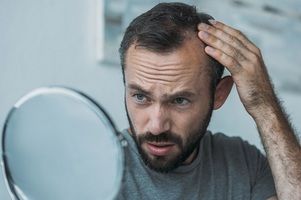
Although it’s considered a minimally invasive and safe cosmetic procedure, hair transplant involves some complications and minimal side effects.
Hair transplant side effects are unavoidable, but it has low complication rates as compared to cosmetic surgical operations. To reduce the severity of these complications it’s very crucial to adhere to the post-operative instructions and do the operation at the most professional and best hair transplant clinic.
Almost every patient experience all or at least some of the side effects of hair transplant that we’ll discuss in this article. Some of these complications are normal and manageable while others require a specialist’s consultation to help reduce them.
So, if you’re planning on undergoing a hair transplant but fear the potential risks make sure to read this article.
What are the Hair Transplant Side Effects to Expect after the Operation?
Below is a list of 10 hair transplant complications that are generally experienced after the operation. The list is ordered from the most common to the least common side effects.
- Swelling and Inflammation:
One of the main side effects seen in all patients after hair transplant is swelling of the face. Swelling mainly targets the forehead and under the eyes. In some extreme cases of swelling, patients find it difficult to open their eyes properly. The image below of one of the patients shows how the forehead starts swelling 2 days after the operation. The swelling starts to occur 2 days after the hair transplant procedure and lasts up to 3-4 days. The reason why the face becomes swollen is that the fluids that were injected into the scalp during the operation are discharged.
The swelling starts to occur 2 days after the hair transplant procedure and lasts up to 3-4 days. The reason why the face becomes swollen is that the fluids that were injected into the scalp during the operation are discharged.
To reduce the swelling it’s recommended to sleep with your head elevated using two pillows. Also, applying a cold compress on the forehead and the cheeks for 15 minutes every two hours will speed up reducing it.
More about swelling after hair transplant was discussed in this article.
- Scalp Numbness:
Losing sensation of the scalp for a while is another common but temporary hair transplant side effect and it shouldn’t raise concerns. Mostly numbness is associated with nerve damage and it could take up to 6 months to fully recover and completely restore sensation.
Are you still curious about losing sensation after a hair transplant? You can read more in this article about numbness after a hair transplant.
Feeling itchy is actually a good sign which indicates that your scalp and nerves are healing very well.
- Scabbing:
Scabbing is the formation of crust in the transplanted areas which occurs during the first week after hair transplant. Scab Formation after Hair Transplant
Scab Formation after Hair TransplantThe creation of scabs is a normal stage of the healing process. It protects the wounds created on the scalp while opening the incisions to place the grafts.
The scabs start to fall off within 10-15 days by washing the hair daily or as instructed by the clinic. You might also realize that while washing, hair is coming off with shedding scabs.
This is totally normal and nothing to worry about. The transplanted hair starts shedding after 2 weeks post-hair transplant and by the 3rd month, it starts to regrow.
Learn more about how and when to get rid of scabs after a hair transplant.
Itching:
Having the urge to scratch the scalp after hair transplant is very common among patients. As reported by patients who have undergone the procedure, itching occurs in the donor area more than in the transplanted sites.
This could last up to one month and there is no need to use any medications to reduce it. However, if patients cannot endure it, their doctor can prescribe a soothing cream to lessen the feeling of itchiness. Read more about the reasons for feeling itching after a hair transplant.
Warning: Remember not to scratch or rub the area where you feel itchy to prevent harming or losing the newly transplanted hair grafts.
Scalp Laxity:
The laxity of the skin could be affected after hair transplant and this is also a temporary side effect. Laxity or lax skin refers to the elasticity of the skin and how it can be easily stretched or pinched.
It’s very rare that patients report a loss of skin laxity and a feeling of tension or as if the skin is tight. However, this is one of the hair transplant risks that patients could experience after the procedure.
Redness and Bleeding:
Redness on the donor and recipient sites is very normal after a hair transplant which doesn’t take more than 10 or 15 days to disappear. Bleeding on the other side is not widely witnessed among patients unless they were uncareful and try to peel off the scabs.
To avoid the risk of bleeding it’s advised to refrain from any physical and strenuous activities that could worsen the bleeding.
Shock Hair Loss:
 Temporary donor area shock after hair transplant
Temporary donor area shock after hair transplant
This a trauma that triggers the old hair (not the transplanted) in both the donor site and the areas surrounding the transplanted sites. This causes the hair to enter a resting phase and fall off temporarily.
There is nothing to worry about since the hair grows back again over the course of 6 months. You can read more details about shock hair loss, in this article.
Cysts/Pimples:
Sometime after a hair transplant, cysts/pimples appear on the scalp, but this is not a common thing that patients face regularly. This could happen due to the placement of grafts very deep into the scalp or ingrown hair. Normally, cysts disappear by themselves but if they don’t it’s recommended to consult a dermatologist.
Necrosis:
Necrosis is the death of skin tissues due to many factors that could go wrong during a hair transplant. Some amateur hair transplant clinics that promise patients to transplant a big number of grafts in a single session usually result in necrosis. Rare necrosis case after hair transplant
Rare necrosis case after hair transplant
Transplanting hair grafts very close to each other in an attempt to achieve the highest density could eventually block and disrupt blood circulation. Also, opening canals very deeply could interrupt the blood flow.Thus, patients have to be aware of these risks, especially ones that are dangerous like Necrosis. This can be easily avoided by selecting the best hair transplant surgeon who sincerely cares about his/her patients.
- Infections:
Infections after a hair transplant can happen due to multiple reasons including lack of sanitation and using contaminated surgical tools or poor personal hygiene and excessive sweating. Check out this article about the different reasons for infection after a hair transplant and how to prevent it.
Summary: Hair transplant side effects are inevitable, but the degree of severity and rates differ. The most common side effects witnessed by all patients are swelling, scabbing, redness, scalp numbness and itching.
Recovery after hair transplant
The process of hair transplant recovery is very short especially if it was performed using the Follicular Unit Extraction technique. Patients can resume their normal lives and go back to work or school a week after the surgery. After the 1st week the swelling would have disappeared and patients no more need to worry about their looks.
However, the aforementioned hair transplant side effects take from 7 up to 14 days to totally disappear and heal. The image below shows the healing process and how the hair looks after 10 days.

It is very essential to adhere to the doctor’s instructions post-operation to achieve the best hair transplant results. Some of the important instructions to follow are as follows:
Abstain from drinking alcohol for at least one week.
Do not smoke all types of cigarettes including electronic ones for 2 weeks after hair transplant.
You must avoid any strenuous activities and heavy sports for 1 month.
Sexual intercourse must be avoided for one week after the transplant.
Sleep on your back for the 5 days after hair transplant with your head elevated to reduce swelling.
Avoid bending and kneeling too much for the first week after hair transplant.
Drink at least 2-3 liters of water for the first two weeks post-hair transplant.
Do not cover your head by wearing caps for at least 2 weeks after hair transplant.
Use the medications as prescribed by the clinic.
Avoid direct sunlight exposure for long hours, especially during the first month.
Summary: the healing period after hair transplant is short and does not exceed 15 days. Patients need to follow their doctor’s recommendations to get the best results and speed up the recovery..






Share Your Opinion, Please